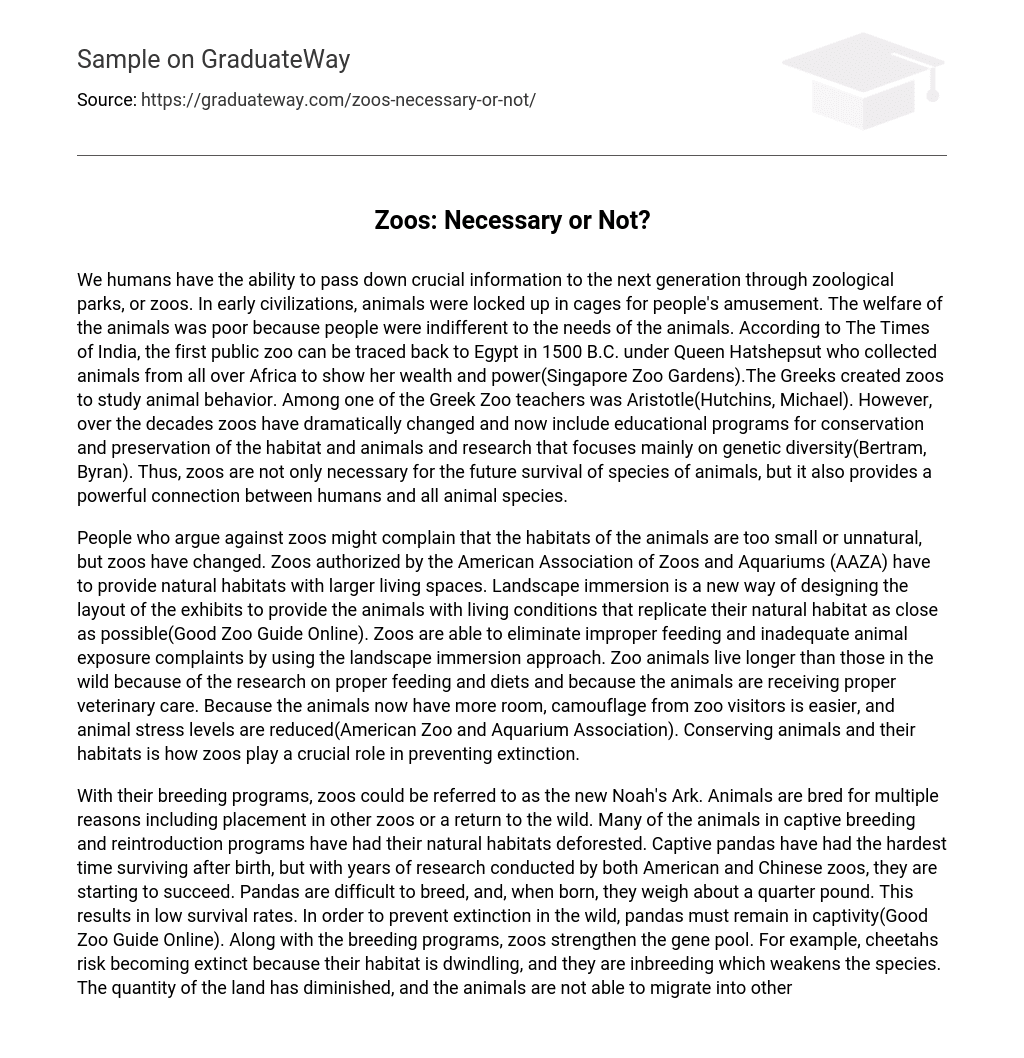We humans have the ability to pass down crucial information to the next generation through zoological parks, or zoos. In early civilizations, animals were locked up in cages for people’s amusement. The welfare of the animals was poor because people were indifferent to the needs of the animals. According to The Times of India, the first public zoo can be traced back to Egypt in 1500 B.C. under Queen Hatshepsut who collected animals from all over Africa to show her wealth and power(Singapore Zoo Gardens).The Greeks created zoos to study animal behavior. Among one of the Greek Zoo teachers was Aristotle(Hutchins, Michael). However, over the decades zoos have dramatically changed and now include educational programs for conservation and preservation of the habitat and animals and research that focuses mainly on genetic diversity(Bertram, Byran). Thus, zoos are not only necessary for the future survival of species of animals, but it also provides a powerful connection between humans and all animal species.
People who argue against zoos might complain that the habitats of the animals are too small or unnatural, but zoos have changed. Zoos authorized by the American Association of Zoos and Aquariums (AAZA) have to provide natural habitats with larger living spaces. Landscape immersion is a new way of designing the layout of the exhibits to provide the animals with living conditions that replicate their natural habitat as close as possible(Good Zoo Guide Online). Zoos are able to eliminate improper feeding and inadequate animal exposure complaints by using the landscape immersion approach. Zoo animals live longer than those in the wild because of the research on proper feeding and diets and because the animals are receiving proper veterinary care. Because the animals now have more room, camouflage from zoo visitors is easier, and animal stress levels are reduced(American Zoo and Aquarium Association). Conserving animals and their habitats is how zoos play a crucial role in preventing extinction.
With their breeding programs, zoos could be referred to as the new Noah’s Ark. Animals are bred for multiple reasons including placement in other zoos or a return to the wild. Many of the animals in captive breeding and reintroduction programs have had their natural habitats deforested. Captive pandas have had the hardest time surviving after birth, but with years of research conducted by both American and Chinese zoos, they are starting to succeed. Pandas are difficult to breed, and, when born, they weigh about a quarter pound. This results in low survival rates. In order to prevent extinction in the wild, pandas must remain in captivity(Good Zoo Guide Online). Along with the breeding programs, zoos strengthen the gene pool. For example, cheetahs risk becoming extinct because their habitat is dwindling, and they are inbreeding which weakens the species. The quantity of the land has diminished, and the animals are not able to migrate into other “genetic” pools because humans are building civilizations between two wild places (American Wildlife Federation). The purpose of the AAZA’s Species Survival Plan (SSP) is to ensure breeding programs for a selected group of rare species in North America Zoos.
One problem with captive breeding is that unless the endangered animals’ habitats are preserved, then they will have nowhere to go beyond the zoo(American Wildlife Federation). Zoos educate the public about animals and their habitats. People have become separated from the natural world, and they have become more reliant on technological and domestic environments(The Humane Society of the United States). Therefore, zoos are now links to nature. Educating children at the zoos will perhaps encourage careers or professions related to animals. Zoos teach the human guests what exotic animals are and how to care for them. Many argue that zoos are not needed in today’s society because it is depressing to see animals in cages. Some people believe that pictures are a good enough substitute for viewing animals and that zoos are fundamentally wrong.
Animal rights group PETA expresses their view that animals are better extinct than confined. Putting the animals in cages is a necessary evil because it serves a greater purpose in the preservation of some animal species(Bertram, Byran). Zoos are necessary because they provide an understanding of the animals and their habitats and create conservation programs for animals to be returned to the wild. Of course, the ideal place for all animals is the wild, but zoos are becoming better places for animals to live. If animals were left alone in the wild, they would most definitely become extinct.





